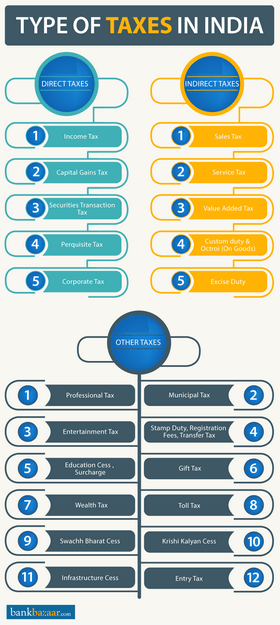வரிகளின் வகைகள்
வரிகள் இரண்டு தனித்துவமான வகைகள், நேரடி மற்றும் மறைமுக வரிகள். இந்த வரிகள் செயல்படுத்தப்படும் வழியில் வேறுபாடு வருகிறது. பயங்கரமான வருமான வரி, செல்வ வரி, கார்ப்பரேட் வரி போன்ற சிலவற்றை நீங்கள் நேரடியாக செலுத்துகிறீர்கள், அதே நேரத்தில் மற்றவை மதிப்பு கூட்டப்பட்ட வரி, சேவை வரி, விற்பனை வரி போன்ற மறைமுக வரிகள் ஆகும்.
1. நேரடி வரிகள்
2. மறைமுக வரி
ஆனால், இந்த இரண்டு வழக்கமான வரிகள் தவிர, மேலும் உள்ளன பிற வரிகள் அது ஒரு குறிப்பிட்ட நிகழ்ச்சி நிரலுக்கு சேவை செய்ய மத்திய அரசாங்கத்தால் செயல்படுத்தப்பட்டுள்ளது. ‘சமீபத்தில் அறிமுகப்படுத்தப்பட்ட ஸ்வச் பாரத் செஸ் வரி, கிருஷி கல்யாண் செஸ் வரி மற்றும் உள்கட்டமைப்பு செஸ் வரி போன்ற நேரடி மற்றும் மறைமுக வரிகள் இரண்டிலும் மற்ற வரிகள் விதிக்கப்படுகின்றன.
1. நேரடி வரி
முன்னர் குறிப்பிட்டுள்ளபடி, நேரடி வரி, நீங்கள் நேரடியாக செலுத்தும் வரிகள் ஆகும். இந்த வரிகள் நேரடியாக ஒரு நிறுவனம் அல்லது ஒரு தனிநபர் மீது விதிக்கப்படுகின்றன மற்றும் வேறு எவருக்கும் டிரான்ஸ்ஃபர் செய்ய முடியாது. இந்த நேரடி வரிகளை கவனிக்கும் சடலங்களில் ஒன்று மத்திய நேரடி வரி வாரியம் (சிபிடிடி) இது வருவாய் துறையின் ஒரு பகுதியாகும். இது, அதன் கடமைகளுடன் உதவுவதற்கு, நேரடி வரிகளின் பல்வேறு அம்சங்களை நிர்வகிக்கும் பல்வேறு செயல்களின் ஆதரவு.
இந்த சட்டங்களில் சில:
· வருமான வரிச் சட்டம்:
இது 1961 ஐடி சட்டம் என்றும் அழைக்கப்படுகிறது மற்றும் இந்தியாவில் வருமான வரியை நிர்வகிக்கும் விதிகளை அமைக்கிறது. இந்த சட்டம் வரிகள், ஒரு வணிகம், வீடு அல்லது சொத்து சொந்தமாக்கல், முதலீடுகள் மற்றும் சம்பளங்களிலிருந்து பெறப்பட்ட லாபங்கள் போன்ற எந்தவொரு ஆதாரத்திலிருந்தும் வரலாம். இது ஒரு நிலையான வைப்புத்தொகை அல்லது ஆயுள் காப்பீட்டு பிரீமியத்தில் எவ்வளவு வரி நன்மை இருக்கும் என்பதை வரையறுக்கும் சட்டமாகும். இது உங்கள் வருமானத்தில் எவ்வளவு சேமிக்க முதலீடுகள் மற்றும் வருமான வரிக்கான ஸ்லாப் என்ன என்பதை தீர்மானிக்கும் சட்டமாகும்.
· செல்வ வரி சட்டம்:
The Wealth Tax Act was enacted in 1951 and is responsible for the taxation related to the net wealth of an individual, a company or a Hindu Unified Family. The simplest calculation of wealth tax was that if the net wealth exceeded Rs. 30 lakhs, then 1% of the amount that exceeded Rs. 30 lakhs was payable as tax. It was abolished in the budget announced in 2015. It has since been replaced with a surcharge of 12% on individuals that earn more than Rs. 1 crore per annum. It is also applicable to companies that have a revenue of over Rs. 10 crores per annum. The new guidelines drastically increased the amount the government would collect in taxes as opposed the amount they would collect through the wealth tax.
·பரிசு வரி சட்டம்:
The Gift Tax Act came into existence in 1958 and stated that if an individual received gifts, monetary or valuables, as gifts, a tax was to be to be paid on such gifts. The tax on such gifts was maintained at 30% but it was abolished in 1998. Initially if a gift was given, and it was something like property, jewellery, shares etc. it was taxable. According to the new rules gifts given by family members like brothers, sister, parents, spouse, aunts and uncles are not taxable. Even gifts given to you by the local authorities is exempt from this tax. How the tax works now is that if someone, other than the exempt entities, gifts you anything that exceeds a value of Rs. 50,000 then the entire gift amount is taxable.
· செலவு வரி சட்டம்:
இது 1987 இல் இருந்த ஒரு சட்டமாகும் மற்றும் ஒரு ஹோட்டல் அல்லது ரெஸ்டாரன்ட் சேவைகளைப் பெறும்போது ஒரு தனிநபராக, நீங்கள் செய்யும் செலவுகளை சமாளிக்கிறது. இது ஜம்மு காஷ்மீர் தவிர அனைத்து இந்தியாவிற்கும் பொருந்தும். ஒரு ஹோட்டல் மற்றும் ஒரு உணவகத்தில் ஏற்படும் அனைத்து செலவுகளும் ரூ. 3,000 ஐ விட அதிகமாக இருந்தால் இந்த சட்டத்தின் கீழ் சில செலவுகள் கட்டணம் வசூலிக்கப்படும் என்று இது கூறுகிறது.
· வட்டி வரி சட்டம்:
1974 வட்டி வரிச் சட்டம் சில குறிப்பிட்ட சூழ்நிலைகளில் சம்பாதித்த வட்டிக்கு செலுத்த வேண்டிய வரியுடன் கையாளுகிறது. இந்த சட்டத்தின் கடைசி திருத்தத்தில் மார்ச் 2000 க்கு பிறகு சம்பாதித்த வட்டிக்கு இந்த சட்டம் பொருந்தாது என்று கூறப்பட்டது.
அனைத்து வகையான நேரடி வரிகளுக்கும் சில எடுத்துக்காட்டுகள் கீழே உள்ளன:

நேரடி வரிகளின் எடுத்துக்காட்டுகள்
நீங்கள் செலுத்தும் நேரடி வரிகளில் சில இவை
ஏ) வருமான வரி:
This is one of the most well-known and least understood taxes. It is the tax that is levied on your earning in a financial year. There are many facets to income tax, such as the tax slabs, taxable income, tax deducted at source (TDS), reduction of taxable income, etc. The tax is applicable to both individuals and companies. For individuals, the tax that they have to pay depends on which tax bracket they fall in. This bracket or slab determines the tax to be paid based on the annual income of the assessee and ranges from no tax to 30% tax for the high income groups.
பொது வரி செலுத்துவோர், மூத்த குடிமக்கள் (60 வயது முதல் 80 வயதுக்கு இடைப்பட்டவர்கள், மற்றும் மிக மூத்த குடிமக்கள் (80 வயதுக்கு மேல் உள்ளவர்கள்) ஆகிய பல்வேறு தனிநபர்களுக்கு வெவ்வேறு வரி அடுக்குகளை அரசாங்கம் நிர்ணயித்துள்ளது.
பி) மூலதன ஆதாய வரி:
This is a tax that is payable whenever you receive a sizable amount of money. It could be from an investment or from the sale of a property. It is usually of two types, short term capital gains from investments held for less than 36 months and long term capital gains from investments held for longer than 36 months. The tax applicable for each is also very different since the tax on short term gains is calculated based in the income bracket that you fall in and the tax on long term gains is 20%. The interest thing about this tax is that the gain doesn’t always have to be in the form of money. It could also be an exchange in kind in which case the value of the exchange will be considered for taxation.
சி) பத்திர பரிவர்த்தனை வரி:
பங்குச் சந்தையில் சரியாக வர்த்தகம் செய்வது மற்றும் பத்திரங்களில் வர்த்தகம் செய்வது உங்களுக்குத் தெரிந்தால், நீங்கள் கணிசமான தொகையை பெறுவீர்கள் என்பது உங்களுக்குத் தெரியாது. இதுவும் வருமானத்தின் ஆதாரமாகும், ஆனால் இது அதன் சொந்த வரியைக் கொண்டுள்ளது, இது பத்திரங்கள் பரிவர்த்தனை வரி என்று அழைக்கப்படுகிறது. இந்த வரி எவ்வாறு விதிக்கப்படுகிறது என்பது பங்கின் விலையில் வரியை சேர்ப்பது. இதன் பொருள் நீங்கள் ஒவ்வொரு முறையும் பங்குகளை வாங்கும்போது அல்லது விற்கும்போது, நீங்கள் இந்த வரியை செலுத்துவீர்கள். இந்திய பங்குச் சந்தையில் வர்த்தகம் செய்யப்படும் அனைத்து பத்திரங்களும் இந்த வரியைக் கொண்டுகிறது.
டி) மேல் வருமான வரி:
Perquisites are all the perks or privileges that employers may extend to employees. These privileges may include a house provided by the company or a car for your use, given to you by the company. These perks are not just limited to big compensation like cars and houses, they can even include things like compensation for fuel or phone bills. How this tax is levied is by figuring out how that perk has been acquired by the company or used by the employee. In the case of cars, it may be so that a car provided by the company and used for both personal and official purposes is eligible for tax whereas a car used only for official purposes is not.
இ) பெருநிறுவன வரி:
Corporate tax is the income tax that is paid by companies from the revenue they earn. This tax also comes with a slab of its own that decides how much tax the company has to pay. For example a domestic company, which has a revenue of less than Rs. 1 crore per annum, won’t have to pay this tax but one that has a revenue of more than Rs. 1 crore per annum will have to pay this tax. It is also referred to as a surcharge and is different for different revenue brackets. It is also different for international companies where the corporate tax may be 41.2% if the company has a revenue of less than Rs. 10 million and so on.
நான்கு வெவ்வேறு வகையான கார்ப்பரேட் வரிகள் உள்ளன. அவை:
· குறைந்தபட்ச மாற்று வரி:
குறைந்தபட்ச மாற்று வரி, அல்லது எம்ஏடி, அடிப்படையில் வருமான வரித் துறைக்கு நிறுவனங்கள் குறைந்தபட்ச வரி செலுத்துவதற்கான வழியாகும், இது தற்போது 18.5%. ஆகும். வருமான வரிச் சட்டத்தின் பிரிவு 115JA அறிமுகப்படுத்துவதன் மூலம் இந்த வரி விதிப்பு நடைமுறைக்கு வந்தது. இருப்பினும், உள்கட்டமைப்பு மற்றும் மின் துறைகளில் சம்பந்தப்பட்ட நிறுவனங்களுக்கு எம்ஏடி செலுத்துவதிலிருந்து விலக்கு அளிக்கப்படுகிறது.
ஒரு நிறுவனம் எம்ஏடி-ஐ செலுத்தியவுடன், அது சில நிபந்தனைகளுக்கு உட்பட்டு அடுத்தடுத்த ஐந்தாண்டு காலத்தில் செலுத்த வேண்டிய வழக்கமான வரிக்கு எதிராக கட்டணத்தை முன்னோக்கி எடுத்துச் செல்லலாம் மற்றும் செட்-ஆஃப் (சரிசெய்யலாம்).
· ஃப்ரின்ஜ் நன்மை வரி:
ஃப்ரிஞ்ச் நன்மை வரி, அல்லது எஃப்பிடி, ஒரு முதலாளி அவர்களின் ஊழியர்களுக்கு வழங்கப்பட்ட கிட்டத்தட்ட ஒவ்வொரு ஃப்ரிஞ்ச் நன்மைக்கும் பொருந்தக்கூடிய வரியாக இருந்தது. இந்த வரியில், பல அம்சங்கள் காப்பீடு செய்யப்பட்டன. அவற்றில் சில உள்ளடங்கும்:
i) பயணத்திற்கான முதலாளியின் செலவு (எல்டிஏ), பணியாளர் நலன், தங்குமிடம் மற்றும் பொழுதுபோக்கு.
ii) எந்தவொரு வழக்கமான பயண அல்லது பயண தொடர்பான செலவு ஒரு முதலாளியால் வழங்கப்படுகிறது.
iii) சான்றளிக்கப்பட்ட ஓய்வூதிய நிதிக்கு முதலாளியின் பங்களிப்பு.
iv) முதலாளி பங்கு விருப்பத் திட்டங்கள் (ESOPகள்).
ஏப்ரல் 1, 2005. முதல் இந்திய அரசாங்கத்தின் மேலாண்மையின் கீழ் எஃப்பிடி தொடங்கப்பட்டது. இருப்பினும், பின்னர் 2009 மத்திய பட்ஜெட் அமர்வின் போது அப்போதைய நிதி அமைச்சர் பிரணாப் முகர்ஜி மூலம் 2009 ஆம் ஆண்டில் வரி தடுக்கப்பட்டது.
· ஈவுத்தொகை விநியோக வரி:
2007-யின் யூனியன் பட்ஜெட் முடிந்த பிறகு லாபப்பங்கு விநியோக வரி அறிமுகப்படுத்தப்பட்டது. இது அடிப்படையில் தங்கள் முதலீட்டாளர்களுக்கு செலுத்தும் லாபப்பங்கு அடிப்படையில் நிறுவனங்கள் மீது விதிக்கப்படும் வரியாகும். இந்த வரி ஒட்டுமொத்த அல்லது நிகர வருமானத்தில் பொருந்தும் ஒரு முதலீட்டாளர் தங்கள் முதலீட்டிலிருந்து பெறுவார். தற்போது, டிடிடி விகிதம் 15% ஆக உள்ளது.
· வங்கி பண பரிவர்த்தனை வரி:
வங்கி ரொக்க பரிவர்த்தனை வரி என்பது இந்திய அரசாங்கத்தால் கைவிடப்பட்ட மற்றொரு வடிவமாகும். அப்போதைய எஃப்எம் பிரணாப் முகர்ஜி வரியை இரத்து செய்யும் வரை இந்த வரிவிதிப்பு 2005-2009 இலிருந்து செயல்பட்டது. ஒவ்வொரு வங்கி பரிவர்த்தனைக்கும் (டெபிட் அல்லது கிரெடிட்) 0.1% விகிதத்தில் வரி விதிக்கப்படும் என்று இந்த வரி பரிந்துரைத்தது.
2. மறைமுக வரி:
வரையறையின்படி, மறைமுக வரிகள் பொருட்கள் அல்லது சேவைகள் மீது விதிக்கப்படும் வரிகள் ஆகும். அவை நேரடி வரிகளில் இருந்து வேறுபடுகின்றன, ஏனெனில் அவை நேரடியாக அரசாங்கத்திற்கு செலுத்தும் ஒரு நபரின் மீது விதிக்கப்படாது, மாறாக அவை தயாரிப்புகள் மீது விதிக்கப்படுகின்றன மற்றும் ஒரு இடைத்தரகரால் சேகரிக்கப்படுகின்றன, தயாரிப்பை விற்கும் நபர். மறைமுக வரியின் மிகவும் பொதுவான எடுத்துக்காட்டுகள் மறைமுக வரி VAT (மதிப்பு கூட்டப்பட்ட வரி), இறக்குமதி செய்யப்பட்ட பொருட்கள் மீதான வரிகள், விற்பனை வரி போன்றவை. இந்த வரிகள் சேவை அல்லது தயாரிப்பின் விலையில் சேர்ப்பதன் மூலம் விதிக்கப்படுகின்றன, இது தயாரிப்பின் செலவை அதிகரிக்கிறது.
மறைமுக வரிகளின் உதாரணங்கள்:
நீங்கள் செலுத்தும் பொதுவான மறைமுக வரிகளில் சில இவை.
ஏ) விற்பனை வரி:
பெயர் குறிப்பிடுவது போல், விற்பனை வரி என்பது ஒரு தயாரிப்பின் விற்பனையில் விதிக்கப்படும் ஒரு வரியாகும். இந்த தயாரிப்பு இந்தியாவில் உற்பத்தி செய்யப்பட்ட அல்லது இறக்குமதி செய்யப்பட்ட ஒன்றாக இருக்கலாம் மற்றும் வழங்கப்பட்ட சேவைகளையும் கூட காப்பீடு செய்யலாம். இந்த வரி விற்பனையாளரின் மீது விதிக்கப்படுகிறது, அவர் தயாரிப்பின் விலையில் சேர்க்கப்பட்ட விற்பனை வரியுடன் தயாரிப்பை வாங்கிய நபருக்கு அதை டிரான்ஸ்ஃபர் செய்கிறார். இந்த வரியின் வரம்பு என்னவென்றால், ஒரு குறிப்பிட்ட தயாரிப்பிற்கு மட்டுமே இது விதிக்கப்பட முடியும், அதாவது தயாரிப்பு இரண்டாவது முறை விற்கப்பட்டால், விற்பனை வரியை பயன் முடியாது.
அடிப்படையில், நாட்டில் உள்ள அனைத்து மாநிலங்களும் தங்கள் சொந்த விற்பனை வரிச் சட்டத்தை பின்பற்றுகின்றன மற்றும் தங்களுக்கு உள்நாட்டு சதவீதத்தை வசூலிக்கின்றன. இது தவிர, ஒரு சில மாநிலங்கள் வருவாய் வரி, வாங்குதல் வரி, பணி பரிவர்த்தனை வரி மற்றும் அதன் போன்ற மற்ற கூடுதல் கட்டணங்களையும் விதிக்கின்றன. இது பல்வேறு மாநில அரசுகளுக்கான மிகப்பெரிய வருவாய் உருவாக்குபவர்களில் ஒன்றாகும். மேலும், இந்த வரி மத்திய மற்றும் மாநில சட்டங்களின் கீழ் விதிக்கப்படுகிறது.
B) சேவை வரி:
Like sales tax is added to the price of goods sold in India, so is service tax added to services provided in India. In the reading of the budget 2015, it was announced that the service tax will be raised from 12.36% to 14%. It is not applicable on goods but on companies that provide services and is collected every month or once every quarter based on how the services are provided. If the establishment is an individual service provider then the service tax is paid only once the customer pays the bills however, for companies the service tax is payable the moment the invoice is raised, irrespective of the customer paying the bill.
நினைவில் கொள்ள வேண்டிய ஒரு முக்கியமான விஷயம் என்னவென்றால், ஒரு உணவகத்தில் சேவை என்பது உணவு, காத்திருப்பு மற்றும் வளாகத்தின் கலவையாக இருப்பதால், சேவை வரிக்கு தகுதி பெறுவதை குறிப்பிடுவது கடினமாகும். எந்தவொரு அம்சத்தையும் அகற்றுவதற்கு, இது தொடர்பாக, உணவகங்களில் சேவை வரி மொத்த பில்லில் 40% மீது மட்டுமே விதிக்கப்படும் என்று அறிவிக்கப்பட்டுள்ளது.
- ஜிஎஸ்டி - பொருட்கள் மற்றும் சேவை வரி:
The Goods and Services Tax (GST) is the largest reform in India’s indirect tax structure since the market started opening up about 25 years ago. The GST is a consumption-based tax, as it is applicable where consumption takes place. The GST is levied on value-added goods and services at each stage of consumption in the supply chain. The GST payable on the procurement of goods and services can be set off against the GST payable on the supply of goods and services, the merchant will pay the applicable GST rate but can claim it back through the tax credit mechanism.
C) மதிப்பு கூட்டப்பட்ட வரி:
வணிக வரி என்றும் அழைக்கப்படும் VAT, பூஜ்ஜிய மதிப்பிடப்பட்ட பொருட்கள் (எ.கா. உணவு மற்றும் அத்தியாவசிய போதைப்பொருட்கள்) அல்லது ஏற்றுமதியின் கீழ் வரும் பொருட்களுக்கு பொருந்தாது. இந்த வரி சப்ளை செயினின் அனைத்து நிலைகளிலும் விதிக்கப்படுகிறது, உற்பத்தியாளர்கள், டீலர்கள் மற்றும் விநியோகஸ்தர்கள் முதல் இறுதி பயனர் வரை.
The value added tax is a tax that is levied at the discretion of the state government and not all states implemented it when it was first announced. The tax is levied on various goods sold in the state and the amount of the tax is decided by the state itself. For example in Gujrat the government split all the good into various categories called schedules. There are 3 schedules and each schedule has its own VAT percentage. For Schedule 3 the VAT is 1%, for schedule 2 the VAT is 5% and so on. Goods that have not been classified into any category have a VAT of 15%.
டி) சுங்க வரி & நகர் சுங்க வரி:
When you purchase anything that needs to be imported from another country, a charge is applied on it and that is the customs duty. It applies to all the products that come in via land, sea or air. Even if you bring in products bought in another country to India, a customs duty can be levied on it. The purpose of the customs duty is to ensure that all the goods entering the country are taxed and paid for. Just as customs duty ensures that goods for other countries are taxed, octroi is meant to ensure that goods crossing state borders within India are taxed appropriately. It is levied by the state government and functions in much the same way as customs duty does.
இ) கலால் வரி:
இது இந்தியாவில் உற்பத்தி செய்யப்பட்ட அல்லது தயாரிக்கப்பட்ட அனைத்து பொருட்கள் மீதும் விதிக்கப்படும் ஒரு வரியாகும். இது சுங்க வரியிலிருந்து வேறுபட்டது ஏனெனில் இது இந்தியாவில் உற்பத்தி செய்யப்படும் விஷயங்களுக்கு மட்டுமே பொருந்தும் மற்றும் இது மத்திய மதிப்பு கூட்டப்பட்ட வரி அல்லது சென்வாட் என்றும் அழைக்கப்படுகிறது. இந்த வரி பொருட்களின் உற்பத்தியாளரிடமிருந்து அரசாங்கத்தால் சேகரிக்கப்படுகிறது. இது உற்பத்தி செய்யப்பட்ட பொருட்களை பெறும் மற்றும் பொருட்களை உற்பத்தியாளரிடமிருந்து தங்களுக்கு கொண்டு செல்ல மக்களை பயன்படுத்தும் நிறுவனங்களிலிருந்தும் சேகரிக்கப்படலாம்.
மத்திய அரசாங்கத்தால் அமைக்கப்பட்ட மத்திய எக்சைஸ் விதி எந்தவொரு 'எக்ஸைஸ் செய்யக்கூடிய பொருட்களை' உற்பத்தி செய்யும் அல்லது உற்பத்தி செய்யும் ஒவ்வொரு நபரும், அல்லது அத்தகைய பொருட்களை ஒரு கிடங்கில் சேமிக்கும் ஒவ்வொரு நபரும், அத்தகைய பொருட்களுக்கு பொருந்தக்கூடிய வரியை செலுத்த வேண்டும் என்பதை பரிந்துரைக்கிறது. இந்த விதியின் கீழ், எந்தவொரு கடமையும் செலுத்த வேண்டிய எந்தவொரு காலாவதியான பொருட்களும் இல்லை, அங்கு அவை உற்பத்தி செய்யப்படுகின்றன அல்லது தயாரிக்கப்படுகின்றன.














